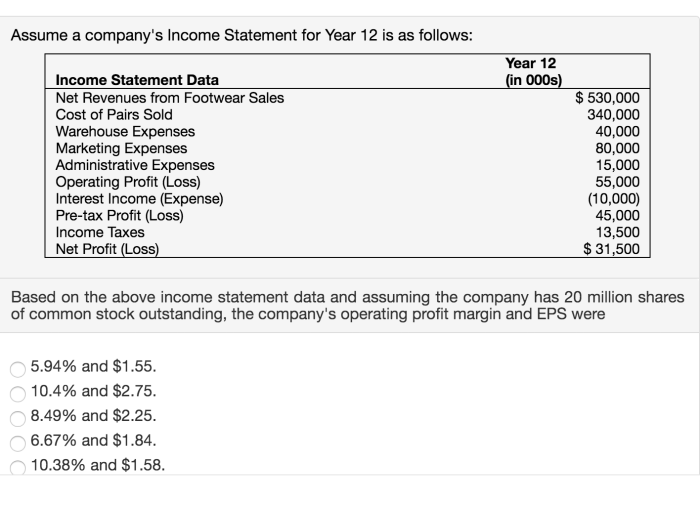A company’s distribution and warehouse expenses play a critical role in supply chain management, directly impacting overall operational efficiency and profitability. Understanding these expenses, their types, and effective strategies for analysis and reduction is essential for businesses seeking to optimize their logistics operations.
This comprehensive guide provides a detailed overview of distribution and warehouse expenses, covering their categorization, analysis methods, cost-saving strategies, and industry benchmarks, empowering businesses to make informed decisions and achieve optimal performance.
Distribution and Warehouse Expenses Overview

Distribution and warehouse expenses encompass the costs incurred in storing and distributing products from the point of production to the end customer. These expenses are crucial for businesses as they impact the overall efficiency and profitability of their supply chain.
Examples of distribution and warehouse expenses include:
- Warehouse rent or lease payments
- Utilities (electricity, water, heating/cooling)
- Equipment costs (forklifts, conveyor belts)
- Labor expenses (warehouse staff, truck drivers)
- Inventory carrying costs
- Transportation costs
Optimizing distribution and warehouse expenses is essential for businesses to minimize costs, improve efficiency, and enhance customer satisfaction. By implementing effective strategies, companies can reduce waste, increase productivity, and gain a competitive advantage.
Types of Distribution and Warehouse Expenses

| Category | Description | Examples |
|---|---|---|
| Fixed Costs | Expenses that remain relatively constant regardless of activity levels. |
|
| Variable Costs | Expenses that fluctuate with activity levels. |
|
| Indirect Costs | Expenses that support distribution and warehousing but are not directly related to specific activities. |
|
| Overhead Costs | Expenses that are allocated to distribution and warehousing based on usage or other factors. |
|
Methods to Analyze Distribution and Warehouse Expenses
To analyze distribution and warehouse expenses effectively, follow these steps:
- Gather data:Collect detailed data on all distribution and warehouse expenses, including invoices, contracts, and internal records.
- Classify expenses:Categorize expenses based on the types Artikeld earlier (fixed, variable, indirect, overhead).
- Calculate key performance indicators (KPIs):Track metrics such as inventory turnover, warehouse utilization, and transportation costs per unit to assess efficiency.
- Identify areas for improvement:Analyze the data and KPIs to pinpoint areas where expenses can be reduced or optimized.
- Develop improvement plans:Implement strategies to address inefficiencies and reduce costs, such as optimizing inventory management, negotiating better transportation rates, or automating processes.
Strategies to Reduce Distribution and Warehouse Expenses: A Company’s Distribution And Warehouse Expenses

To reduce distribution and warehouse expenses, consider the following strategies:
- Optimize inventory management:Implement just-in-time (JIT) inventory systems, reduce safety stock levels, and improve inventory accuracy.
- Negotiate better transportation rates:Establish long-term contracts with carriers, optimize shipping routes, and leverage technology for real-time tracking and optimization.
- Automate processes:Utilize technology to automate tasks such as order picking, inventory management, and shipping, reducing labor costs and errors.
- Consolidate warehouses:Centralize operations by consolidating multiple warehouses into a single, larger facility, reducing overhead costs.
- Outsource non-core activities:Consider outsourcing non-core functions such as transportation or warehousing to specialized providers, potentially reducing costs and improving efficiency.
Benchmarking Distribution and Warehouse Expenses

Benchmarking distribution and warehouse expenses involves comparing your company’s performance against industry standards or best practices.
| Metric | Industry Benchmark |
|---|---|
| Inventory turnover | 8-12 times per year |
| Warehouse utilization | 80-90% |
| Transportation costs per unit | 5-10% of sales |
Benchmarking can help identify areas for improvement and set realistic goals for expense reduction.
Common Queries
What are the key types of distribution and warehouse expenses?
Distribution expenses include transportation costs, inventory holding costs, and order fulfillment costs. Warehouse expenses encompass rent or mortgage payments, utilities, equipment maintenance, and labor costs.
How can companies analyze their distribution and warehouse expenses?
Effective analysis involves tracking key performance indicators (KPIs) such as inventory turnover, order cycle time, and warehouse utilization. Companies can also conduct activity-based costing to allocate expenses accurately.
What are some strategies to reduce distribution and warehouse expenses?
Strategies include optimizing inventory levels, negotiating favorable shipping rates, implementing warehouse automation, and leveraging technology to improve efficiency and reduce labor costs.